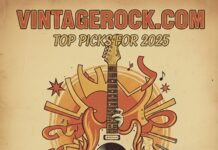By Henry “Dixie” Howard
What do you do when you’re ousted from one of England’s most prominent progressive rock bands? You strike out (or come back) by forming your own band. That’s precisely what guitarist Peter Banks, a founding member of Yes, did.
In 1970, Yes (Jon Anderson, Chris Squire, Peter Banks, Tony Kaye and Bill Bruford) was a band on the rise. Despite being extremely talented with huge ambitions, Yes still hadn’t crossed that threshold to international success and fame. Their 1969 self-titled debut glimpsed at the musical frontiers they wanted to conquer. So, when sessions for their sophomore release started, they strived to expand their horizons even further.
When they enlisted producer Tony Colton to add orchestration, problems started brewing. Colton immediately took a disliking to Banks, who wanted the band to retain their live feel and voiced his distain of the orchestration. Time And A Word, the resulting album, has Banks and keyboardist Kaye buried in the mix and the orchestration overpowering (and shadowing) their parts.
Shortly after the sessions, Banks was asked (?) to leave Yes, and Tomorrow guitarist Steve Howe was recruited to take his place. Howe even replaced Banks in the group cover photo for the U.S. release of Time And A Word. It must be noted that Peter Banks, who came up with the Yes moniker, was (and still is) a very unique and talented guitarist with a wide range of influences. Many also believe that Howe simply elaborated on a style Banks created for Yes.
What Next?
Without a gig to fall back on, Banks wasn’t quite sure of his future at this point and joined Blodwyn Pig. The band was started by ex-Jethro Tull guitarist Mick Abrahams, who had vacated his leadership position. Banks was in his eighth month with the now abbreviated Blodwyn Pig when he was contacted by singer Colin Carter, himself briefly with the embolic Camel. Upon their second sit down, the two wrote a song called “Small Beginnings,” and Flash was born in late 1971. The duo recruited bassist Ray Bennett and drummer Mike Hough, and recorded a demo version of “Small Beginnings.” Based on the demo, the band was immediately signed to Sovereign/EMI in Europe and Capitol in the States.
What Did They Sound Like?
Flash was a very appropriate name for this new band. Banks had an arsenal of guitar fire power to unleash. He combined high speed jazz rock licks with a hard rock edge over complex and shifting rhythm patterns, while still tastefully injecting quiet passages that soared to crescendos. Banks was also quite the showman who knew how to work an audience.
Bennett’s Rickenbacker bass skills were also very much to the fore, as he constantly played unison or counter lines with Banks while locking in with Hough’s dynamic drumming. On top of all that was Carter’s pure tenor voice. Rail thin, the singer also had a large curly mane that Roger Daltrey would’ve envied. Freshly removed from the Yes ranks, Tony Kaye played keyboards on the debut album, but only as a guest. After all, Kaye had Badger, his own band, in the works.
It could be said that Flash was an extremely talented band with huge ambitions. Sound familiar? When Flash’s self-titled debut was released, Yes had already made their commercial breakthrough with The Yes Album (1971), followed by the hugely successful Fragile album in early 1972.
Based on the success of Yes, one would think Flash would have had a warm and accepting audience waiting in the wings. But being a key player in creating the “Yes sound” proved to be a double-edge sword. “Small Beginnings” did receive quite a bit of radio airplay, and was eventually released as a single, reaching Number 29 in the Billboard Top 40. Unfortunately, many a critic and unknowing music fan dismissed them as mere Yes sound-alikes.
Undeterred, In The Can, the group’s second album was quickly recorded and released in late 1972. Although it received favorable reviews, Flash couldn’t shake the “sounds (too much) like Yes” tag.
One thing that may not have endeared them to Yes fans was the group’s (what we would now call) sexist album covers (Not that there’s anything wrong with that, mind you). All courtesy of the highly regarded Hipgnosis, they were “eye catchers” for sure, but hardly representative of the music.
Marching onward, Banks and company stayed true to themselves. In 1973, they recorded what would be their final album Out Of Our Hands. A lack of label support and an apathetic audience lead to them calling it a day. Back in the 60s and 70s, bands had to project their own identity; whereas today, cloning and copycat artists are encouraged.
Flash worked their arses off. In their brief two-year existence, they toured hard and constantly, supporting the likes of Genesis, Humble Pie, Alice Cooper, Roxy Music, Black Sabbath, Todd Rundgren, Santana, Joe Walsh, Uriah Heep, Steve Miller, The Byrds, Grand Funk Railroad, Chuck Berry, Jeff Beck, Badfinger, Foghat, Mott The Hoople, J Geils Band, Earth Wind & Fire and many more. They lived on the road.
In 1973, Banks issued a solo album called The Two Sides Of Peter Banks, and then formed Empire, a new group that recorded three albums from 1974 through 1978. Empire music lay dormant until it was released in 1995.
Psychosync, a live Flash CD culled from two performances, was released in 1997. It consists of a 1972 radio broadcast and two tracks from their 1973 Midnight Special TV appearance. If you like guitar-driven progressive rock and missed Flash back in the day, check out their CDs.
~
Flash discography:
Flash (1972)
In The Can (1972)
Out Of Your Hands (1973)
Psychosync (1997)
Peter Banks solo discography:
Two Sides Of Peter Banks (1973)
Instinct (1993)
Self-Contained (1995)
Reduction (1999)
Can I Play You Something? (1999
Ray Bennett solo discography:
Whatever Falls (2001)
Angels & Ghosts (2001)
For more information, visit:
http://www.psychosync.info/index.htm
http://www.myspace.com/guitaristpeterbanks
http://www.bennettmusic.com




















